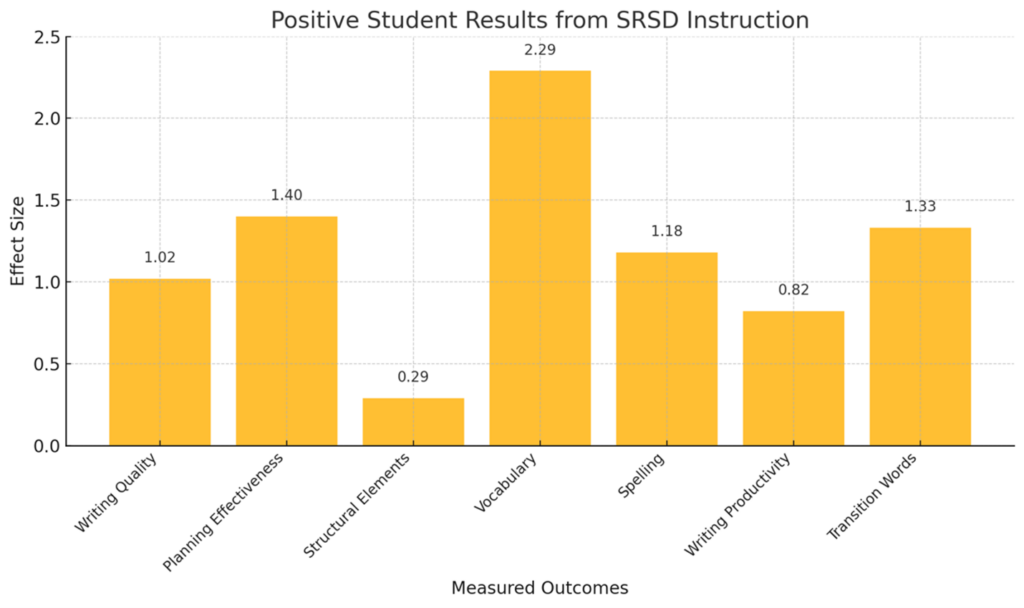Writing Strategies for Elementary Students: SRSD for Grades 1 and 2

Engaging Young Writers: Practical Tips and Activities
In a groundbreaking study, Yes. They Can: Developing transcription skills and oral language in tandem with SRSD instruction on close reading of science text to write informative essays at grades 1 and 2, published in the research journal Contemporary Educational Psychology, Harris et al. (2023) explored the transformative potential of combining Self-Regulated Strategy Development (SRSD) with explicit instruction in transcription and oral language skills, plus close reading of science texts for first and second-graders.
The study was conducted with students in a high-poverty school. It is the first to investigate whether young children should learn foundational skills before learning to compose a written text. The findings demonstrated significant improvements in writing quality, planning, vocabulary, and structural elements of students’ essays, showcasing the power of evidence-based, multi-component instruction to elevate early literacy outcomes. These results provide a compelling case for integrating writing process instruction with skills-based approaches in primary classrooms, addressing critical gaps in early literacy education.
Introduction
Writing is a critical skill that is the foundation for academic success, personal development, and future career opportunities. Despite its importance, writing instruction, including instructional opportunities at the early grade levels, is often lacking. There have been ongoing debates and questions about whether students should learn transcription and oral language skills before learning skills for writing. However, “Yes, They Can…” demonstrates that combining skills with effective writing strategies and instruction yields remarkable results, even in first and second-grade classrooms.
Why Focus on Young Writers?
The early grades are pivotal for developing literacy skills, but insufficient instruction can affect students in the long term. Data from the National Assessment of Educational Progress (NAEP) highlights concerning trends. Only 27% of U.S. eighth and twelfth graders perform at or above the proficient level in writing, with significant disparities among students from underserved communities. Similarly, many students struggle with reading comprehension, which is intricately linked to writing success. The NAEP reading data: 34% of fourth graders scored below basic, and only 35% scored at or above proficient. For 8th graders, 27% scored below basic, and only 34% scored at or above proficient.
Addressing these challenges requires integrating evidence-based practices, such as SRSD, into early writing instruction. SRSD’s structured approach helps students develop self-regulation, planning, and writing strategies, laying a strong foundation for lifelong literacy.
Overview of the Study
The randomized controlled trial included 93 first- and second-grade students from a high-poverty school. Participants were randomly assigned to either the “SRSD Plus” group or a control group with typical writing instruction (writers’ workshop in this case). Over 10 weeks, students in the SRSD Plus group received instruction three times per week for 45 minutes per session. Key components of SRSD Plus included:
- SRSD for Writing: Strategies for planning, composing, and revising informative essays, supported by close reading of science texts aligned with the Next Generation Science Standards (NGSS).
- Transcription Skills: Explicit instruction in handwriting and spelling to enhance fluency.
- Vocabulary and Sentence Structure: Focused activities to build tier 2 and content-specific vocabulary and sentence proficiency activities, including combining and completion.
Key Findings
This graph shows the positive impact of SRSD (Self-Regulated Strategy Development) instruction on various writing-related skills for elementary students. The bars represent the effect sizes for different outcomes, with a higher effect size indicating a more substantial improvement. Vocabulary showed the most prominent effect (2.29), demonstrating significant gains in students’ word knowledge and use. Planning effectiveness (1.40), transition words (1.33), and spelling (1.18) also showed substantial improvements. Writing quality improved by an effect size of 1.02, and writing productivity saw a more minor but meaningful boost (0.82). The structural elements of writing, like organizing essays, showed the smallest gain (0.29), indicating this may require further focus.

The study’s results showcase the transformative impact of SRSD Plus on young learners:
Improved Writing Quality: Students in the SRSD Plus group achieved significantly higher writing quality scores than their peers, with an effect size of 1.02. First graders in the intervention group produced writing that matched the quality of second graders in the control group, indicating a substantial improvement in writing quality.
Enhanced Writing Productivity: Students in the SRSD Plus group wrote longer, more detailed compositions. First graders increased their average word count from 16 to 52 words per composition. Second graders wrote nearly twice as many words as their control group peers.
Mastery of Structural Elements: The intervention significantly improved students’ use of structural elements, such as topic sentences, big ideas, and conclusions, aligning with Common Core State Standards (CCSS) expectations.
Stronger Vocabulary and Sentence Proficiency: The focus on Tier 2 vocabulary (high-utility words) and complex sentence structures led to measurable gains:
a. Vocabulary Effect Size: 2.29 (large effect).
b. Sentence Proficiency Effect Size: 0.29 (moderate effect).
Effective Planning Skills: Students learned to create detailed, goal-oriented plans for their writing. These plans included key ideas, supporting details, and organizational notes with a very large 1.40 effect size.
Reading-Writing Integration: By closely reading science texts, students improved their ability to extract key ideas and use them effectively in their writing, utilizing available resources to enhance their learning process. This integration of reading and writing supports comprehension and content learning.
Breaking Barriers in Early Writing Instruction
This study addresses longstanding debates about whether elementary students can handle the cognitive demands of integrating transcription, oral language, and writing strategies. The findings demonstrate that:
- Cognitive Overload Concerns are Unfounded: Young learners can successfully manage these complex tasks with proper scaffolding and support.
- Equity in Literacy Instruction is Achievable: SRSD Plus provided a structured approach to meet the needs of all students and gave them access to evidence-based, effective literacy instruction.
Practical Implications for Teachers
For educators, the study offers clear guidance on implementing SRSD techniques and writing strategies for elementary students to support early writing development:
Explicit and Systematic Instruction: Integrate curriculum-aligned content by breaking down complex tasks into manageable steps, guiding students through each stage of the writing process.
Integration of Reading and Writing: Students should read informational texts closely to build content knowledge and provide a basis for writing tasks.
Scaffolded Learning: Gradually release responsibility to students after providing explicit modeling, allowing them to develop independence while maintaining high expectations.
Frequent Practice: Provide regular opportunities and resources for students to write, plan, and revise their work, emphasizing the importance of engagement, perseverance, and self-regulation throughout the writing process.
Combine Skills Instruction with Compositional Instruction: Incorporate activities that build handwriting fluency, spelling accuracy, vocabulary, and sentence complexity alongside strategic instruction for writing.
Conclusion
The study by Dr. Karen Harris and colleagues underscores the power of SRSD and writing strategies for elementary students to unlock young learners’ writing potential. By integrating evidence-based practices for reading, writing, and skills instruction in a content area, educators can empower their students to become confident, skilled writers who excel academically and beyond. For teachers seeking to make a lasting impact, SRSD provides a proven framework for fostering success in the classroom and beyond.

About the Author
Randy Barth is CEO of SRSD Online, which innovates evidence-based writing instruction grounded in the Science of Writing for educators. Randy is dedicated to preserving the legacies of SRSD creator Karen Harris and renowned writing researcher Steve Graham to make SRSD a standard practice in today’s classrooms. For more information on SRSD, schedule a risk-free consultation with Randy using this link: Schedule a time to talk SRSD.





